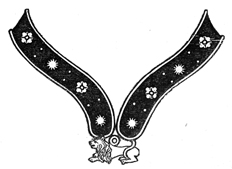|
only represented on his tomb, which he had erected
during Henry's reign, with the collar of SS, but the
chantry, also built by him, is profusely ornamented with
the same collar, enclosing his monogram, J. B. He
probably received the privilege of wearing it during
Henry's visit to St. Edmundsbury, in 1433.1
In all the instances where I have found a trace of
the position of the parties, they evidently held some
office connected with the Crown, or were otherwise
attached to the reigning family, and were not mere
knights. The weight of evidence clearly preponderates
in favour of the hypothesis, that those only were entitled
to wear this collar who were in some way connected
with the royal household or service.
On the accession of Edward IV., the Yorkist collar
of roses and suns was of course adopted, and to its clasp
the white lion of the House of Marche was commonly
attached.

THE COUNTESS OF ESSEX.
But the collar of SS was revived by Henry VII; and the frequent insurrections in that king's reign would
have the natural effect of inducing his partisans to distinguish
themselves by his emblem. The consequence
was, that by degrees it was assumed by unprivileged
persons; so that when eventually the two houses ceased
1 Bury Wills (Canden Soc.), pp.
15-44, 233.
|